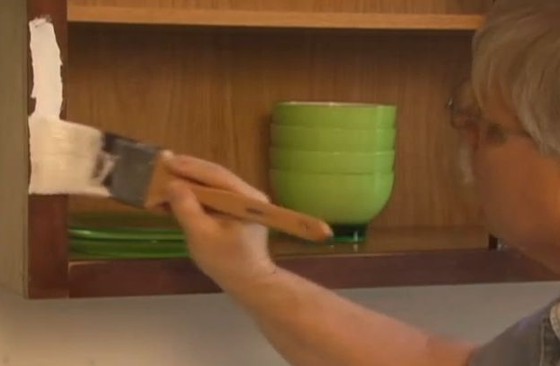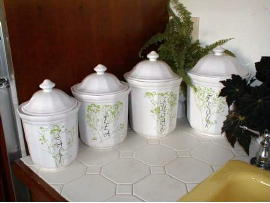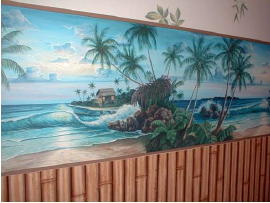Tim's Ten Secret Wall Glazing Tips
Secret Tip #1 Choose Your Method
There are two ways to apply glaze, the negative and positive techniques. The negative method is harder to do and is often used by pros. In this method you simply use a standard paint roller and apply glaze all over the wall. You then use a rag roller to remove excess glaze to a desired level/appearance that you like. You almost always need two people to do this because the glaze can dry before you remove it.
The positive method is the one I used. You simply dip the rag roller in the glaze and apply it to the wall as you would any regular paint. You still need to work quickly even if you use an extender.
Secret Tip #2 Practice!
Several walls in my basement have four coats of paint and five coats of glaze on them. I didn't plan to do that many, trust me! It takes a little practice to get the feel of how the glaze works and the rag roller applies it. I feel the best way is to simply practice on a separate piece of drywall. Just paint it on the floor and practice applying the glaze. Let the glaze dry and see what happens if you apply a thin coat over just part of the dried glaze. You will see why you must work fast as the color is distinctly darker in the double coverage area.
Secret Tip #3 Color Selection
Picking and mixing the right glaze color can be a challenge. The background or base paint color and the glaze color seem to work best when they are from the same color family. Color families are what you see on paint color strips. Notice how the colors go from lighter to darker on the same strip? This is all one family. Keep in mind that the lightest color on a strip can often be made lighter by mixing the formula half strength.
When you select your glaze color, always have the paint store employee mix it two shades lighter than the color you picked. For some reason they always seem to come out much darker if you mix it the actual formula you call for. The lighter colored formula should create the real color you are looking for. The color of the wet glaze inside the can just after mixing is the color it will dry. Paints often dry darker than what they look like wet.
Secret Tip #4 Wall Prep
The walls must be ready to go before you start. The glaze simply dries too quickly for you to be monkeying around with cover plates, masking off areas, spreading drop clothes or whatever.
Secret Tip #5 Paint Without Trim Where Possible
The hardest thing to do when glazing is to end the glaze in a corner or up against woodwork. In new construction it is possible to glaze the walls before trim is applied. You have to have a great carpenter who will watch the walls, but it is possible. This is what I did in my basement. I also used a trick up at the ceiling. I installed an eight inch wide wallpaper border so I wouldn't have to get the glaze tight against the ceiling. If you apply the trim after the glaze, take the time to pre-paint the trim so you get a finished look as soon as it is nailed to the wall.
Secret Tip #6 Starting and Stopping
Once you start to glaze a wall, you can't stop. You must proceed from a corner to a corner. If you double coverage an area, it will really show. Apply the glaze randomly on the wall. Do not make a crisp vertical line from the floor to the ceiling as you apply the glaze. Make the edge look as ragged as possible. You will blend into this as you move down the wall.
Secret Tip #7 Inside Corners
You must mask off inside corners to prevent glaze getting on a wall surface you are not working on. Use a special low tack masking tape. I like the 3M Safe Release white masking tape #2070. Apply the tape so that it is 1/16th inch away from the actual centerline of the corner. This allows you to get just a trace of glaze on the wall surface you are not working on. Then when you mask this corner later in the day to do the unfinished wall, apply the tape in the exact center of the corner. This gives you excellent coverage in the corner. If you do get water based glaze on a surface where it should not be, it can be removed if you act quickly. Keep a bucket of warm soapy water and a sponge handy. Use it to wipe glaze off a wall surface, trim, etc.
Secret Tip #8 Cutting Into Corners
The rag roller will not get perfectly into the corner. Use a simple brush and dab glaze into the corner to get you started. Dab it as randomly as possible to create the look of the rag roller. Only dab as you go. Do not let this glaze dry! You can run the rag roller over it to get as close as possible to the corner. Practice to see what I mean. Poor results can be wiped off the wall immediately with the soapy water.
Secret Tip #9 Have Plenty of Rag Roller Covers
The fabric that covers the rag roller wears out fairly quickly. I had to use three of them to finish my basement room. I was surprised at how quickly holes developed in the material. It is understandable since the rag rollers take lots of direct abuse as you twist them and rotate them on the walls. They can be cleaned and reused but don't expect them to last and last as a high quality paint roller cover might.
Secret Tip #10 Don't Be Afraid To Start Over
Attack a small wall first. When you are finished, stand back and look at it. The glaze should just be a thin coating that creates a magical 3D look. Some areas of the wall will have more glaze than others giving it the look of leather. If you don't like the look, let the glaze dry and repaint the wall with the base or undercoat color. I had to do this on a number of walls because I was not satisfied with the results. One person only should do the rag rolling. They will develop a specific technique that a helper may not be able to match.
Column B384


